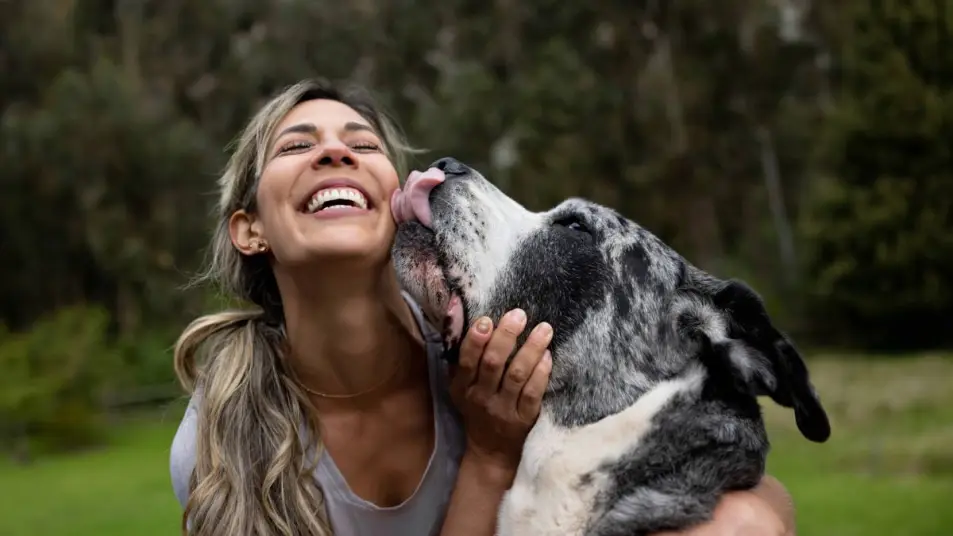Unveiling the Reasons Behind Your Dog’s Licking Habit
For many dog owners, the sight of their furry companion showering them with enthusiastic licks is a heartwarming sign of affection. But have you ever wondered why dogs lick us so much? This guide delves into the fascinating reasons behind this common canine behavior, exploring the communication, instinct, and emotional motivations that drive your dog’s wet kisses.
A Lick of History: The Evolution of Canine Licking
The origins of dog licking can be traced back to their wolf ancestors. Here’s how licking behavior might have evolved:
- Puppy Care: Mother dogs lick their puppies to clean them, stimulate urination and defecation, and show affection. This behavior is ingrained in young dogs and can be carried over into adulthood.
- Social Communication: In wolf packs, subordinate members lick the dominant animals as a submissive gesture and a sign of appeasement. This behavior might translate into licking humans as a sign of respect and affection.
- Tasting the World: Dogs use their tongues to explore and understand their environment. Licking you could simply be their way of gathering information about your taste and scent.
A Language of Licks: Decoding Your Dog’s Communication
The way your dog licks you can offer clues about their emotional state and intentions:
- Gentle Licks: Soft, lingering licks are often a sign of affection and bonding. Your dog might be expressing contentment or seeking your attention.
- Exuberant Licks: Fast, excited licks can be a greeting behavior or a sign of playful excitement.
- Apprehensive Licks: If your dog licks you accompanied by submissive postures like lowered ears or tucked tail, it might indicate nervousness or appeasement.
- Persistent Licks: Constant, obsessive licking could be a sign of anxiety, boredom, or a compulsive behavior.
Beyond Affection: Other Reasons for Licking
While affection is a significant motivator, here are some other reasons why your dog might lick you:
- Seeking Attention: Licking can be a learned behavior that your dog has discovered gets them a reaction or a treat.
- Medical Conditions: Skin allergies, dental problems, or nausea can cause excessive licking. If licking becomes compulsive, consult your veterinarian.
- Calming Mechanism: Licking can be a self-soothing behavior for dogs experiencing stress or anxiety.
Managing the Licks: Setting Boundaries with Love
While some licking is perfectly normal, excessive licking can become a nuisance. Here are some ways to manage your dog’s licking behavior:
- Redirect with Positive Reinforcement: When your dog licks excessively, gently redirect them with a toy or a command like “sit.” Reward them for following your instructions.
- Ignore Unwanted Licks: If your dog licks you for attention, simply don’t react. This might extinguish the behavior if they don’t get the desired response.
- Address Underlying Issues: If licking seems compulsive or anxiety-driven, consult your veterinarian or a professional dog trainer to address potential medical or behavioral problems.
FAQ: Frequently Asked Questions About Dog Licking
- Q: Is it okay for my dog to lick my face?
A: While a quick lick on the cheek might be harmless, allowing your dog to lick your face frequently is not recommended. Dogs’ mouths can harbor bacteria, and licking can transmit germs.
- Q: Why does my dog lick my feet?
A: There are several reasons: affection, seeking attention, or a sign of submission. Pay attention to your dog’s body language for clues.
- Q: How do I stop my dog from licking excessively?
A: Redirection, ignoring unwanted licks, and addressing underlying causes are effective strategies. Consult a veterinarian or trainer for persistent issues.
- Q: Should I lick my dog back?
A: This is not recommended. Dogs communicate through licking, but it might confuse your dog and isn’t an effective way to train them.
- Q: Does my dog licking me mean they are happy?
A: Licking can be a sign of affection and happiness, but it can also indicate other emotions. Consider the context and your dog’s overall behavior.
Remember: Understanding the reasons behind your dog’s licking behavior allows you to respond appropriately and strengthen the bond between you and your furry companion. Enjoy the occasional wet kiss, but set gentle boundaries when necessary.
Bonus Section: Lickety-Split Fun: Activities to Channel Your Dog’s Licking Energy
Licking is a natural canine behavior, but sometimes it can become excessive. Here are some fun activities to redirect your dog’s licking tendencies and provide them with mental and physical stimulation:
-
Interactive Lick Mats: These silicone mats have grooves and ridges where you can spread wet food, peanut butter, or yogurt. Licking the mat keeps your dog occupied and provides mental stimulation.
-
Frozen Kong Toys: Stuff a Kong toy with kibble, treats, or wet food and freeze it. Licking the frozen Kong helps cool your dog down and keeps them busy trying to extract the goodies.
-
Scatter Feeding: Instead of pouring food in a bowl, scatter kibble around the house or yard for your dog to sniff and search for. This mimics natural foraging behavior and provides mental enrichment.
-
Chew Toys: Provide your dog with a variety of chew toys made from safe materials like rubber or nylon. Chewing helps clean teeth, relieves boredom, and satisfies their natural chewing instinct.
-
Training Sessions: Engage your dog in short, positive reinforcement training sessions. This provides mental stimulation, strengthens your bond, and gives them an outlet for their energy.
By incorporating these activities into your dog’s routine, you can offer them alternative behaviors to licking and keep them mentally and physically stimulated. This not only reduces unwanted licking but also fosters a happy and well-rounded canine companion.






More Stories
Where to Watch USMNT vs Jamaica National Football Team
How I Met My Monster
How Should a Ring Fit